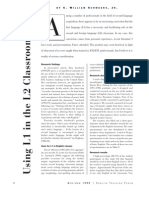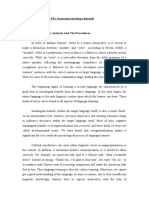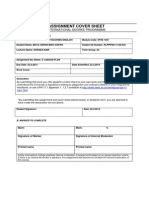0 ratings0% found this document useful (0 votes)
101 viewsSome Methodological in Language Teaching
Some Methodological in Language Teaching
Uploaded by
Kerr Dwight DuranoThis document discusses language teaching methodology. It defines methodology as selecting, sequencing and justifying learning tasks and experiences. It outlines the history of the "methods debate" in language teaching and the shift towards more communicative and learner-centered approaches like Communicative Language Teaching. More recently, task-based language teaching has realized CLT through lessons based on tasks with non-linguistic outcomes that connect classroom learning to real-world language use. The document concludes by outlining some principles for effective language teaching methodology, including focusing on the learner, developing a personal methodology, using a pre-task, task, post-task cycle, and employing various classroom techniques and tasks.
Copyright:
© All Rights Reserved
Available Formats
Download as DOCX, PDF, TXT or read online from Scribd
Some Methodological in Language Teaching
Some Methodological in Language Teaching
Uploaded by
Kerr Dwight Durano0 ratings0% found this document useful (0 votes)
101 views4 pagesThis document discusses language teaching methodology. It defines methodology as selecting, sequencing and justifying learning tasks and experiences. It outlines the history of the "methods debate" in language teaching and the shift towards more communicative and learner-centered approaches like Communicative Language Teaching. More recently, task-based language teaching has realized CLT through lessons based on tasks with non-linguistic outcomes that connect classroom learning to real-world language use. The document concludes by outlining some principles for effective language teaching methodology, including focusing on the learner, developing a personal methodology, using a pre-task, task, post-task cycle, and employing various classroom techniques and tasks.
Original Description:
Some Methodological in Language Teaching
Copyright
© © All Rights Reserved
Available Formats
DOCX, PDF, TXT or read online from Scribd
Share this document
Did you find this document useful?
Is this content inappropriate?
This document discusses language teaching methodology. It defines methodology as selecting, sequencing and justifying learning tasks and experiences. It outlines the history of the "methods debate" in language teaching and the shift towards more communicative and learner-centered approaches like Communicative Language Teaching. More recently, task-based language teaching has realized CLT through lessons based on tasks with non-linguistic outcomes that connect classroom learning to real-world language use. The document concludes by outlining some principles for effective language teaching methodology, including focusing on the learner, developing a personal methodology, using a pre-task, task, post-task cycle, and employing various classroom techniques and tasks.
Copyright:
© All Rights Reserved
Available Formats
Download as DOCX, PDF, TXT or read online from Scribd
Download as docx, pdf, or txt
0 ratings0% found this document useful (0 votes)
101 views4 pagesSome Methodological in Language Teaching
Some Methodological in Language Teaching
Uploaded by
Kerr Dwight DuranoThis document discusses language teaching methodology. It defines methodology as selecting, sequencing and justifying learning tasks and experiences. It outlines the history of the "methods debate" in language teaching and the shift towards more communicative and learner-centered approaches like Communicative Language Teaching. More recently, task-based language teaching has realized CLT through lessons based on tasks with non-linguistic outcomes that connect classroom learning to real-world language use. The document concludes by outlining some principles for effective language teaching methodology, including focusing on the learner, developing a personal methodology, using a pre-task, task, post-task cycle, and employing various classroom techniques and tasks.
Copyright:
© All Rights Reserved
Available Formats
Download as DOCX, PDF, TXT or read online from Scribd
Download as docx, pdf, or txt
You are on page 1of 4
Some Methodological in Language Teaching
What is methodology?
The field of curriculum development is large and complex. It includes
all of the planned learning experiences in an educational setting. Curriculum
has three subcomponents: syllabus design, methodology, and evaluation.
Syllabus design has to do with selecting, sequencing and justifying content.
Methodology has to do with selecting, sequencing, and justifying learning
tasks and experiences. Evaluation has to do with how well students have
mastered the objectives of the course and how effectively the course has
met their needs.
Background to language teaching methodology
The methods debate
A language teaching method is a single set of procedures which
teachers are to follow in the classroom. Methods are also usually based on a
set of beliefs about the nature of language and learning. For many years, the
goal of language pedagogy was to find the right method a
methodological magic formula that would work for all learners of all times
(Brown,2002). Methods contrast with approaches, which are more general,
philosophical orientations such as communicative language teaching that
can encompass a range of different procedures.
Communicative Language Teaching (CLT)
During the 1970s, a major reappraisal of language occurred Linguists
began to look at language, not as interlocking sets of grammatical, lexical
and phonological rules, but as a tool for expressing meaning. This
reconceptualization had a profound effect on language teaching
methodology. In the earliest versions of CLT, meaning was emphasized over
form, fluency over accuracy. It also led to the development of differentiated
courses that reflected the different communicative needs of learners. This
needs-based approach also reinforced another trend that was emerging at
the time-that of learner-centered education (Nuna, 1988).
In the recent years, the broad approach known as CLT has been
realized methodologically by task-based language teaching (TBLT) in TBLT,
language lessons are based on learning experiences that have nonlinguistic
outcomes, and in which there is a clear connection between the things
learners do in class and the things they will ultimately need to do outside of
the classroom. Such tasks might include listening to a weather forecast and
deciding what to wear, ordering a meal, planning a party, finding ones way
around town and so on. In these tasks, language is used to achieve nonlanguage outcomes. For example, the ultimate aim of ordering a meal is not
to use correctly formed wh-questions, but to get to get food and drink on the
table.
Principles for Language Teaching Methodology
1. Focus on the learner
A learner-centered classroom is one in which learners are
actively involved in their own learning processes. There are two
dimensions to this learner involvement. The first of these is the
involvement of learners in making decisions about what to learn,
how to learn, and how to be evaluated. The second is in
maximizing the class time in which the learners, rather than the
teacher do the work.
In relation to the first dimension, it is sometimes argued
that most learners do not have the knowledge or experience to
make informed decisions about what to learn how to learn, and
how to be assessed. According to this view, the teacher is the
boss and it is the professional responsibility of the teacher to
make these decisions. A countervailing view is that ultimately is
the learner who has to do the learning.
One possible solution to this dilemma is for the teacher to
make most of the decisions at the beginning of the learning
process. Then gradually, through a process of learner training
begin developing in the learners the skills they need in order to
begin taking control of their own learning process.
2. Develop your personal methodology
As we saw in the background section of this chapter, the
search for the one best method was exclusive and ultimately
proved to be futile. When researchers looked at what teachers
actually did in the classroom as opposed to what proponents of
one method another said they ought to do, they found that
teachers had a range of practices that were widely used
regardless of the method that any given teacher as supposed to
follow. The major difference lies, not in the tasks themselves, but
in the ordering and prioritizing of the tasks. In other words, in
terms of actual classroom practices the same technique might be
used, but their ordering and emphasis would be different.
3. Build instructional sequences based on a pre-task, task, and
follow-up cycle
Successful instructional sequences share certain things in
common, regardless of the methodological principles or
approaches that drive them. First of all, the main task, whether it
be a drill, a role-play, or a listening comprehension is set up
through one or more pre-tasks. Pre-tasks have several functions:
to create interest, help build students schema in relation to the
topic, introduce key vocabulary, revise a grammatical point, etc.
Following the pre-tasks comes the tasks itself. This will
usually consist of several steps or subtasks. In the
communicative classroom, the teacher will seek to maximize the
time that the students are processing the language or interacting
with each other (although, of course, this will depend on the
rationale for the instructional sequence). The teacher will also
carefully monitor the students to ensure that they know what
they are supposed to do and are carrying out the tasks correctly.
4. Classroom techniques and tasks
You might also like
- Lesson Plan RationaleDocument4 pagesLesson Plan RationaleKeriCALL4870% (1)
- Test-Taking Strategy HughesDocument11 pagesTest-Taking Strategy Hughesapi-296486183No ratings yet
- LIDDICOAT - Five Principles of Intercultural Language LearningDocument2 pagesLIDDICOAT - Five Principles of Intercultural Language LearningBeatriz Peña Dix100% (1)
- Peer TeachingDocument29 pagesPeer TeachingMuhammad FahrieNo ratings yet
- Topic # 1 & 2 Basic Concepts of English For Specifics PurposesDocument16 pagesTopic # 1 & 2 Basic Concepts of English For Specifics PurposesDestianNo ratings yet
- McleodbrandonjournalsandessaysDocument19 pagesMcleodbrandonjournalsandessaysapi-290342899No ratings yet
- The Melting Pot in Ga-Matlala MaserumuleDocument175 pagesThe Melting Pot in Ga-Matlala MaserumuleBongani MaphumuloNo ratings yet
- My Teaching PhilosophyDocument3 pagesMy Teaching Philosophy曹永坤No ratings yet
- Philosophy of Teaching - Geraldine Odiakosa PDFDocument8 pagesPhilosophy of Teaching - Geraldine Odiakosa PDFgerie131No ratings yet
- Task 2: Academic WritingDocument5 pagesTask 2: Academic WritingLiving LegacyNo ratings yet
- Linguistics Analysis of Chinese American EnglishDocument9 pagesLinguistics Analysis of Chinese American EnglishBaiyu LiNo ratings yet
- A Study On Barriers of Cross Cultural CommunicationDocument2 pagesA Study On Barriers of Cross Cultural CommunicationAnonymous 3L7ZroJIzhNo ratings yet
- 17547840hakim Ppce 102605 2018 Self Reflection FormDocument3 pages17547840hakim Ppce 102605 2018 Self Reflection Formapi-408697874No ratings yet
- Giving and Receiving FeedbackDocument3 pagesGiving and Receiving FeedbackTiffany GoodNo ratings yet
- Lesson Plan For Teaching PracticeDocument4 pagesLesson Plan For Teaching PracticeHamLi MiLanisti D'kamikazeNo ratings yet
- Lesson Plan RationaleDocument9 pagesLesson Plan Rationaleapi-381659399No ratings yet
- Code Switching in Indian CultureDocument5 pagesCode Switching in Indian CultureramNo ratings yet
- Limitations of English Teaching in ChinaDocument2 pagesLimitations of English Teaching in ChinaNur AtikahNo ratings yet
- Reflection - A Key To Professional Growth: Two Types of ReflectionDocument10 pagesReflection - A Key To Professional Growth: Two Types of ReflectionQuerobin GampayonNo ratings yet
- Self-Study Project Intrinsic and Extrinsic MotivationDocument7 pagesSelf-Study Project Intrinsic and Extrinsic Motivationapi-247222888No ratings yet
- Module 3 PDFDocument10 pagesModule 3 PDFFreud Bnjie Cblit DoleraNo ratings yet
- Subject AreaDocument8 pagesSubject Areaapi-290342899No ratings yet
- Language Teaching and Testing Relationship in The EFL ContextsDocument7 pagesLanguage Teaching and Testing Relationship in The EFL ContextsAbdiresak HusseinNo ratings yet
- FTP Lesson Plan and RationaleDocument6 pagesFTP Lesson Plan and Rationaleapi-396889383No ratings yet
- Competence and Performance in Language TeachingDocument28 pagesCompetence and Performance in Language TeachingNaserElrmahNo ratings yet
- Using L1 in Esl Class by SchweersDocument5 pagesUsing L1 in Esl Class by SchweersRidzwan Rulam Ahmad100% (1)
- Lesson Plan (Reading) : Teacher: Course Book (Name/unit/page) : Date and Time: Room: Main Topic (Language)Document8 pagesLesson Plan (Reading) : Teacher: Course Book (Name/unit/page) : Date and Time: Room: Main Topic (Language)Yovanny Motolinia OropezaNo ratings yet
- Sociolinguistic VariablesDocument3 pagesSociolinguistic VariablesAhmed S. Mubarak100% (1)
- Analysis of A Lesson PlanDocument8 pagesAnalysis of A Lesson PlanKerriebah Alonzo HelenNo ratings yet
- The Teacher-Student Communication Pattern: A Need To Follow?Document7 pagesThe Teacher-Student Communication Pattern: A Need To Follow?Alexandra RenteaNo ratings yet
- Chapter Eight Total Physical ResponseDocument8 pagesChapter Eight Total Physical ResponseSandy Liseth Cañas CarrilloNo ratings yet
- Target ClassDocument7 pagesTarget Classapi-290342899No ratings yet
- Om Teaching (Journal) : Error Analysis and The EFL ClassroDocument14 pagesOm Teaching (Journal) : Error Analysis and The EFL Classroming87No ratings yet
- Grammar Year 5 Lesson PlanDocument8 pagesGrammar Year 5 Lesson PlanmayaairaniNo ratings yet
- i01-2CC83d01 - Intercultural Communication in English Language Teacher EducationDocument9 pagesi01-2CC83d01 - Intercultural Communication in English Language Teacher EducationMuhammad Iwan MunandarNo ratings yet
- Standard 10 - PartnershipsDocument5 pagesStandard 10 - PartnershipsJoely Seal Rogers100% (1)
- Challeges Facing EFL Teachers in Mixed Ability ClassesDocument13 pagesChalleges Facing EFL Teachers in Mixed Ability ClassesAnonymous rWJCoarANo ratings yet
- Intensive and Extensive ListeningDocument18 pagesIntensive and Extensive ListeningMaria Octa ElsavanaNo ratings yet
- Planning A Writing LessonDocument9 pagesPlanning A Writing LessonZaleha AzizNo ratings yet
- 490354the Oral Error Correction Techniques Used by Libyan Secondary School Teachers of English Muhsen Abobaker A. Ali ADocument315 pages490354the Oral Error Correction Techniques Used by Libyan Secondary School Teachers of English Muhsen Abobaker A. Ali ALouis WilliamNo ratings yet
- L1 in EFL Classes PDFDocument11 pagesL1 in EFL Classes PDFClaudia J. TewuNo ratings yet
- Listening: Elements of Good ListeningDocument17 pagesListening: Elements of Good ListeningGuntur Nara PersadaNo ratings yet
- Pedagogies and Practices in Multilingual Classrooms Singularities in PluralitiesDocument16 pagesPedagogies and Practices in Multilingual Classrooms Singularities in PluralitiesNatalia DureNo ratings yet
- Bringing The Outside World Into The Classroom:: Ways of Making Reading Lessons Less of A Tedious TaskDocument4 pagesBringing The Outside World Into The Classroom:: Ways of Making Reading Lessons Less of A Tedious TaskpaulaNo ratings yet
- Format & PresentationDocument48 pagesFormat & PresentationHizzel De CastroNo ratings yet
- English Language Testing in PakistanDocument14 pagesEnglish Language Testing in PakistanZameer NawazNo ratings yet
- Dictogloss Strategy and Listening Comprehension Performance of Secondary School StudentsDocument12 pagesDictogloss Strategy and Listening Comprehension Performance of Secondary School StudentsSilvi AlizaNo ratings yet
- English Language Learners ReflectionDocument4 pagesEnglish Language Learners ReflectionTina AlyseNo ratings yet
- Lorena ManajDocument3 pagesLorena ManajcarmenNo ratings yet
- Culminating Experience Part 4b Written ReflectionDocument4 pagesCulminating Experience Part 4b Written Reflectionapi-495778531No ratings yet
- Audio Lingual MethodDocument12 pagesAudio Lingual MethodKeviin Mariño VivasNo ratings yet
- Differences Between First Language Acquisition and Second Language LearningDocument2 pagesDifferences Between First Language Acquisition and Second Language LearningMahaletchumy SubramaniamNo ratings yet
- Role of Teacher CLTDocument49 pagesRole of Teacher CLTAnuja DamleNo ratings yet
- SOCIOLINGUISTICS IN ESL CONTEXT (Week 2) (A)Document39 pagesSOCIOLINGUISTICS IN ESL CONTEXT (Week 2) (A)Nurul Intan FairuzNo ratings yet
- Desuggestopedia - Research PaperDocument15 pagesDesuggestopedia - Research PaperUsama MaherNo ratings yet
- Second Language Learner Case Study-2Document27 pagesSecond Language Learner Case Study-2api-318508483No ratings yet
- Functional SyllabusDocument7 pagesFunctional Syllabusxikaf05No ratings yet
- Extensive Listening in CLT in EFL ContextDocument9 pagesExtensive Listening in CLT in EFL ContextAbir BotesNo ratings yet
- The Role of Grammar Teaching in CollegeDocument16 pagesThe Role of Grammar Teaching in CollegeanahitdarbinyanNo ratings yet
- World-Readiness Standards (General) + Language-specific document (GERMAN)From EverandWorld-Readiness Standards (General) + Language-specific document (GERMAN)No ratings yet
- Mind Matters in SLAFrom EverandMind Matters in SLAClare WrightNo ratings yet
- Discourse Community AssignmentDocument6 pagesDiscourse Community Assignmentapi-336505391No ratings yet
- Answer Key 3Document1 pageAnswer Key 3Александр ИванченкоNo ratings yet
- Unit-7: Paragraph DevelopmentDocument5 pagesUnit-7: Paragraph Developmentspandan74No ratings yet
- LECTURE 16 - Using Information Technologies in Teaching Foreign Languages (4 Hours)Document5 pagesLECTURE 16 - Using Information Technologies in Teaching Foreign Languages (4 Hours)Abish MusaevNo ratings yet
- Digital Education Review-n.2012-12-22-Digital StorytellingDocument121 pagesDigital Education Review-n.2012-12-22-Digital StorytellingToni de la TorreNo ratings yet
- Relative Clauses - Divide Into 2 Parts Easy/hardDocument14 pagesRelative Clauses - Divide Into 2 Parts Easy/hardgustavo antonNo ratings yet
- SmanticsDocument18 pagesSmanticskarimaali070No ratings yet
- Creative Writing Week 5 - Day 2Document6 pagesCreative Writing Week 5 - Day 2Chicell Mae MacapayagNo ratings yet
- Formal and Informal Greetings - Basic SpeakingDocument21 pagesFormal and Informal Greetings - Basic SpeakingM KadaviNo ratings yet
- SLP in MalaysiaDocument6 pagesSLP in Malaysiairfeenaa810No ratings yet
- Blueprint of End Semester Examination's Question PaperDocument2 pagesBlueprint of End Semester Examination's Question PaperSoikat DasNo ratings yet
- MIL TG Lesson 10Document2 pagesMIL TG Lesson 10dharvee queenNo ratings yet
- Importance of Market Research For Consumer ProductsDocument4 pagesImportance of Market Research For Consumer ProductspranavNo ratings yet
- GOALS OF VISUAL DESINGN (Resume)Document7 pagesGOALS OF VISUAL DESINGN (Resume)Miftahul JannahNo ratings yet
- LinkedIn Etiquette Refers To The Appropriate and Professional Conduct That Users Should Adhere To When Interacting On The LinkedIn PlatformDocument1 pageLinkedIn Etiquette Refers To The Appropriate and Professional Conduct That Users Should Adhere To When Interacting On The LinkedIn Platformankulkumar54321ewqNo ratings yet
- Classroom Program NLCDocument2 pagesClassroom Program NLCAngel May Sarmiento100% (1)
- Elementary English Review 4 Units 28 35 British English StudentDocument8 pagesElementary English Review 4 Units 28 35 British English StudentSamuel RuibascikiNo ratings yet
- Matras Yaron. 2013. Jenisch. EncyclopediaDocument4 pagesMatras Yaron. 2013. Jenisch. EncyclopediaVirtual 3DNo ratings yet
- Civil War Webquest Rubric NewspaperDocument1 pageCivil War Webquest Rubric Newspaperapi-287096354No ratings yet
- Personal Selling - CH 5 - Using Communication Principles To Build RelationshipsDocument63 pagesPersonal Selling - CH 5 - Using Communication Principles To Build Relationshipsash.khan100% (1)
- Language As A Communicative ToolDocument2 pagesLanguage As A Communicative ToolJoseph AndrewsNo ratings yet
- Week 3Document4 pagesWeek 3Rosette EvangelistaNo ratings yet
- Lesson 7 - Media and GlobalizationDocument18 pagesLesson 7 - Media and GlobalizationReign Cievien CultivoNo ratings yet
- Fatima Zuberi - 21286 - English For Secondary Classes (Content) - Speaking - B.ed. (1.5 Year)Document25 pagesFatima Zuberi - 21286 - English For Secondary Classes (Content) - Speaking - B.ed. (1.5 Year)FatimazuberiNo ratings yet
- Homework Bahasa ArabDocument8 pagesHomework Bahasa Arabafeuqbmfv100% (1)
- Academic Writing Task 1: Describing GraphsDocument2 pagesAcademic Writing Task 1: Describing GraphsEmilio Bernal Moreno100% (1)
- Vocabulary Test Day 11: NameDocument2 pagesVocabulary Test Day 11: NameSueNo ratings yet
- Borang Transit PBD Tahun 6 MawarDocument9 pagesBorang Transit PBD Tahun 6 MawarsalmimanjaNo ratings yet
- AEF3e L2 Endtest A Answer KeyDocument4 pagesAEF3e L2 Endtest A Answer KeyMarla JailerNo ratings yet

























































































